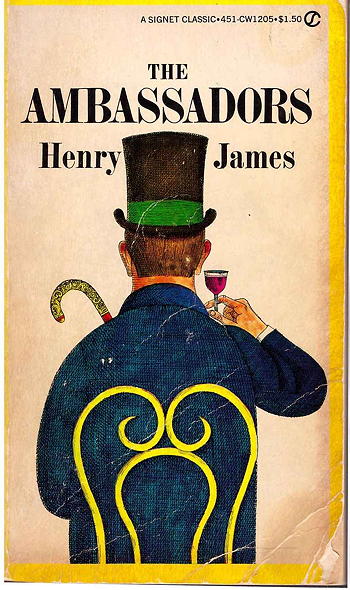The Error in The Ambassadors
The first American edition of Henry James's novel The Ambassadors was published in 1903. But it took 47 years before anyone noticed that there seemed to be a glaring error in it, and the person who noticed was a Stanford undergrad, Robert E. Young. As told by Frances Wilson in the Times Literary Supplement:
The chapters had actually been printed in the correct order in a British edition, published before the American one. But every subsequent American (and British) edition had used the incorrect order, until Young pointed out the mistake.

Young blamed James's writing style for the error. He concluded his 1950 article in the journal American Literature (in which he exposed the error) with this paragraph:
Naturally, this charge riled James's fans, some of whom sought to defend him. Most notably, in 1992 scholar Jerome McGann argued that James might have intended for the chapters to be in that order. From Wikipedia:
It doesn't seem that many people buy McGann's argument, so the consensus remains that the chapters were out of order and James never noticed.
This was no minor mistake but an error of giant proportions, sitting bang in the middle of the book and staring right at you: "Chapters XXVIII and XXIX are in reverse order" (the italics are Young’s). Chapter 28, in which Lambert Strether reports to Maria Gostrey his conversation with Chad Newsome of the night before, precedes the conversation itself which is described in chapter 29. Only when the positions of chapters 28 and 29 are reversed, Young argued, does the chronology make sense...
this reversal of chapters was missed by James, not once but twice. He missed it when he checked the proofs of the novel set by Harper and he missed it again in 1908, during his scrupulous revision of The Ambassadors for Scribner’s New York Edition of his work.
this reversal of chapters was missed by James, not once but twice. He missed it when he checked the proofs of the novel set by Harper and he missed it again in 1908, during his scrupulous revision of The Ambassadors for Scribner’s New York Edition of his work.
The chapters had actually been printed in the correct order in a British edition, published before the American one. But every subsequent American (and British) edition had used the incorrect order, until Young pointed out the mistake.

Young blamed James's writing style for the error. He concluded his 1950 article in the journal American Literature (in which he exposed the error) with this paragraph:
That James possessed many virtues as a novelist is indisputable; however, this discovery seems to add weight to the contention that the style of writing he affected in his later novels is not one of them. Indeed, there must be something radically wrong with a writing style that has managed to obscure an error of this magnitude for so many years from the probing eyes of innumerable readers, publishers, editors, critics, and even the author himself. It does not seem necessary to labor this point.
Naturally, this charge riled James's fans, some of whom sought to defend him. Most notably, in 1992 scholar Jerome McGann argued that James might have intended for the chapters to be in that order. From Wikipedia:
McGann explained the chronological discrepancies by noting that the start of (the Harper edition) chapter 28 tells that it will describe a conversation that will occur in the 'future' (relative to the juncture reached in the story), and that the 'that evening' line, at the start of chapter 29, refers not to the evening just described in chapter 28, but to the previous one.
It doesn't seem that many people buy McGann's argument, so the consensus remains that the chapters were out of order and James never noticed.
Comments
In fact, I'd say that McGann's argument quite proves the point he tries to counter.
Posted by Richard Bos on 03/27/21 at 09:33 AM
Commenting is not available in this channel entry.

Category: Literature | Goofs and Screw-ups